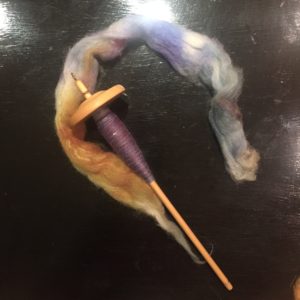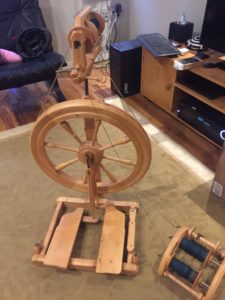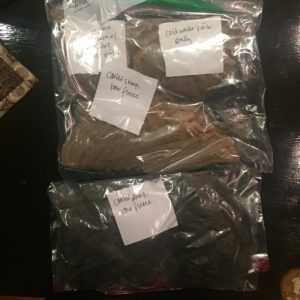I’ve loved yarn and fiber arts almost as long as I’ve loved reading. My mom knit me many sweaters and even more pairs of mittens (which I frequently lost, sorry Mom). A family friend taught me how to crochet when I was eight, in my teens I had an apprenticeship at a weaving shop, and over the years I’ve learned how to:
- Crochet
- Tat (make tatted lace)
- Do macrame and make friendship bracelets–even had a little business selling them in middle school
- Knit
- Weave on a floor loom
- Spin yarn (insert joke about spinning yarns here)
- Nalbinding (a precursor to knitting–samples have been found in viking camps)

There’s something very satisfying to me about creating something from nothing, from raw materials to finished fabric. Spinning is one of the more recent addition to that list. I decided to learn about five years ago, starting with a drop spindle, which is a much cheaper way to begin than buying a wheel.
I’ve always wanted to learn to spin with a drop spindle, because Morgaine in The Mists of Avalon was always going into trances when she spun with her spindle–I might secretly be a sorceress! Viking women used drop spindles; the spinning wheel wasn’t invented until around 1500. Making yarn with a drop spindle is time consuming. Icelandic women were rated as potential wives by how many yards of fabric they could produce in a year. I believe that 40 was a very respectable number.

After spinning up about a pound of wool on my drop spindle, I knew I liked spinning enough to purchase a wheel, which is a bit more of an investment. And so much easier. Still, it takes a few weeks of spinning an hour or so a day for me to turn 4oz of fleece into 400 yards of 3-ply yarn. I can hardly imagine spinning enough yarn to weave the fabric for a sail. From hurstwick.org, “It is estimated that about 35 hours of labor was required to make the thread required for one day of weaving.” Kings might be able to afford imported silk, but most ships had sails made of wool.
And I usually start my spinning with combed top, which is cleaned and dyed, and all of the fibers are facing the same direction so they can easily be spun directly with no further processing. A friend of mind recently sent me some raw wool, which I will have to wash several times, pick through to remove vegetable matter, and finally card into rolags for spinning–far more work than I do with my lovely combed top.

Not only did women spin and weave fabric for nearly every sail, they also clothed their families from birth to death, in wool that had to keep out the harsh Norse winter. Sagas rarely tell of their deeds, but the Vikings would not have been able to cross the North Atlantic without the work of thousands of anonymous women. I’m glad I can spend months spinning and knitting 4 oz of prepared fleece into a beautiful shawl instead.
2 Comments
Hi,
I heard the spinning wheel possibly came from India (roughly 500 AD – 1000 AD). What sources support 1500 for its emergence? I realize my comment must sound combative, but it’s not meant to be. I, too, love Vikings and history. I write Viking romance and have written Viking women processing wool with paddles and urine.
You are absolutely right! I should have been more clear–1500 is when I understand they became prevalent in Europe. Viking women would almost certainly not have had them for spinning the yarn for sails.